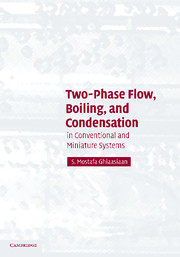Book contents
- Frontmatter
- Contents
- Preface
- Frequently Used Notation
- TWO-PHASE FLOW, BOILING AND CONDENSATION IN CONVENTIONAL AND MINIATURE SYSTEMS
- PART ONE TWO-PHASE FLOW
- 1 Thermodynamic and Single-Phase Flow Fundamentals
- 2 Gas–Liquid Interfacial Phenomena
- 3 Two-Phase Mixtures, Fluid Dispersions, and Liquid Films
- 4 Two-Phase Flow Regimes – I
- 5 Two-Phase Flow Modeling
- 6 The Drift Flux Model and Void–Quality Relations
- 7 Two-Phase Flow Regimes – II
- 8 Pressure Drop in Two-Phase Flow
- 9 Countercurrent Flow Limitation
- 10 Two-Phase Flow in Small Flow Passages
- PART TWO BOILING AND CONDENSATION
- APPENDIX A Thermodynamic Properties of Saturated Water and Steam
- APPENDIX B Transport Properties of Saturated Water and Steam
- APPENDIX C Thermodynamic Properties of Saturated Liquid and Vapor for Selected Refrigerants
- APPENDIX D Properties of Selected Ideal Gases at 1 Atmosphere
- APPENDIX E Binary Diffusion Coefficients of Selected Gases in Air at 1 Atmosphere
- APPENDIX F Henry's Constant of Dilute Aqueous Solutions of Selected Substances at Moderate Pressures
- APPENDIX G Diffusion Coefficients of Selected Substances in Water at Infinite Dilution at 25°C
- APPENDIX H Lennard–Jones Potential Model Constants for Selected Molecules
- APPENDIX I Collision Integrates for the Lennard–Jones Potential Model
- APPENDIX J Physical Constants
- APPENDIX K Unit Conversions
- References
- Index
3 - Two-Phase Mixtures, Fluid Dispersions, and Liquid Films
- Frontmatter
- Contents
- Preface
- Frequently Used Notation
- TWO-PHASE FLOW, BOILING AND CONDENSATION IN CONVENTIONAL AND MINIATURE SYSTEMS
- PART ONE TWO-PHASE FLOW
- 1 Thermodynamic and Single-Phase Flow Fundamentals
- 2 Gas–Liquid Interfacial Phenomena
- 3 Two-Phase Mixtures, Fluid Dispersions, and Liquid Films
- 4 Two-Phase Flow Regimes – I
- 5 Two-Phase Flow Modeling
- 6 The Drift Flux Model and Void–Quality Relations
- 7 Two-Phase Flow Regimes – II
- 8 Pressure Drop in Two-Phase Flow
- 9 Countercurrent Flow Limitation
- 10 Two-Phase Flow in Small Flow Passages
- PART TWO BOILING AND CONDENSATION
- APPENDIX A Thermodynamic Properties of Saturated Water and Steam
- APPENDIX B Transport Properties of Saturated Water and Steam
- APPENDIX C Thermodynamic Properties of Saturated Liquid and Vapor for Selected Refrigerants
- APPENDIX D Properties of Selected Ideal Gases at 1 Atmosphere
- APPENDIX E Binary Diffusion Coefficients of Selected Gases in Air at 1 Atmosphere
- APPENDIX F Henry's Constant of Dilute Aqueous Solutions of Selected Substances at Moderate Pressures
- APPENDIX G Diffusion Coefficients of Selected Substances in Water at Infinite Dilution at 25°C
- APPENDIX H Lennard–Jones Potential Model Constants for Selected Molecules
- APPENDIX I Collision Integrates for the Lennard–Jones Potential Model
- APPENDIX J Physical Constants
- APPENDIX K Unit Conversions
- References
- Index
Summary
Introductory Remarks about Two-Phase Mixtures
The hydrodynamics of gas–liquid mixtures are often very complicated and difficult to rigorously model. A detailed discussion of two-phase flow modeling difficulties and approximation methods will be provided in Chapter 5. For now, we can note that, although the fundamental conservation principles in gas–liquid two-phase flows are the same as those governing single-phase flows, the single-phase conservation equations cannot be easily applied to two-phase situations, primarily because of the discontinuities represented by the gas–liquid interphase and the fact that the interphase is deformable. Furthermore, a wide variety of morphological configurations (flow patterns) are possible in two-phase flow. Despite these inherent complexities, useful analytical, semi-analytical, and purely empirical methods have been developed for the analysis of two-phase flows. This has been done by adapting one of the following methods.
Making idealizations and simplifying assumptions. For example, one might idealize a particular flow field as the mixture of equal-size gas bubbles uniformly distributed in a laminar liquid flow, with gas and liquid moving with the same velocity everywhere. Another example is the flow of liquid and gas in a channel, with the liquid forming a layer and flowing underneath an overlying gas layer (a flow pattern called stratified flow), when the liquid and gas are both laminar and their interphase is flat and smooth. It is possible to derive analytical solutions for these idealized flow situations. However, these types of models have limited ranges of applicability, and two-phase flows in practice are often far too complicated for such idealizations.
[…]
- Type
- Chapter
- Information
- Two-Phase Flow, Boiling, and CondensationIn Conventional and Miniature Systems, pp. 89 - 120Publisher: Cambridge University PressPrint publication year: 2007



